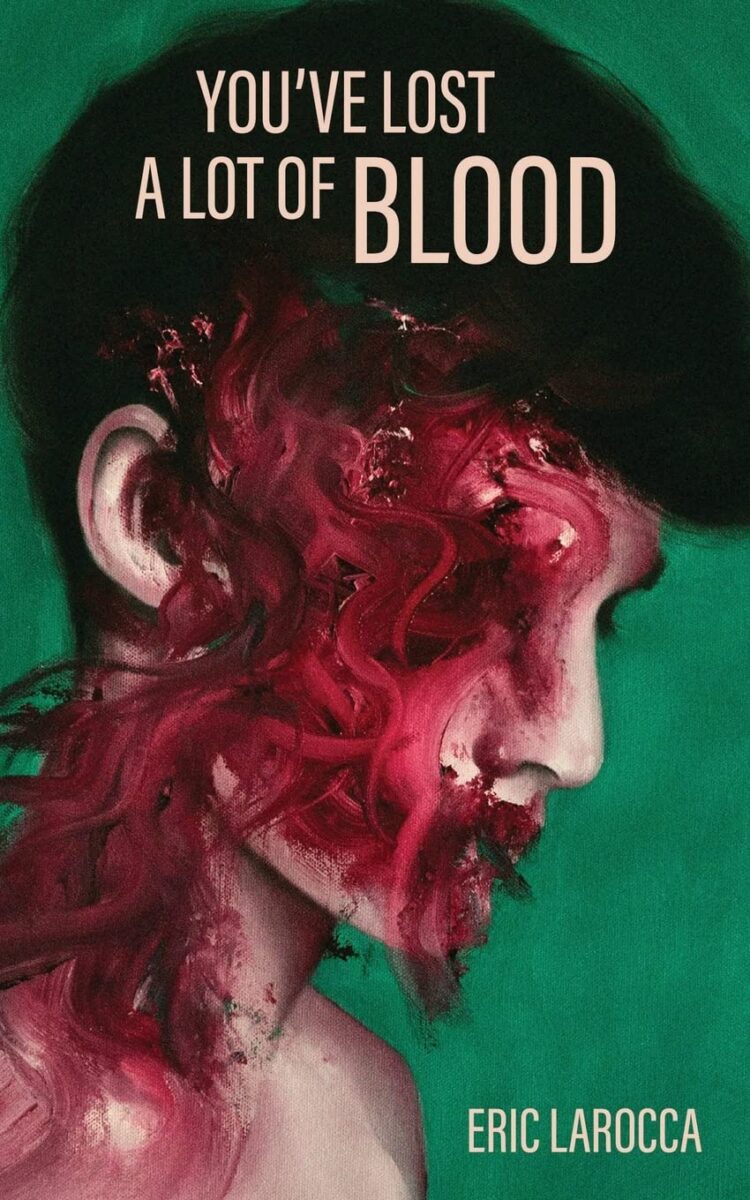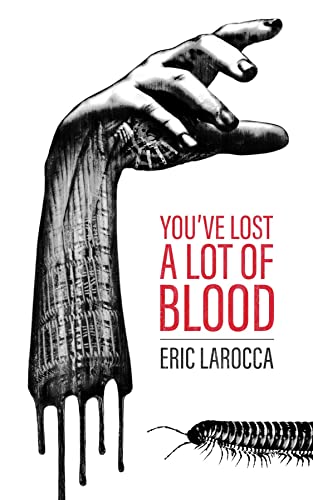Horror is a fairly broad genre. Suspense and gore fall under its umbrella, the subtle and the explicit. Monsters both human and non-human, with and without motive, inhabit its works, and the architects of its worlds seek quite the spectrum of responses. Are you unnerved, or actively nauseous? Do you check under the bed for monsters, or check your own eyes for a psychotic gleam?
Eric LaRocca wants all of this and more from you in You’ve Lost a Lot of Blood. This fascinatingly meta-textual novella is a commentary on the very concept of horror, an experiment conducted with interwoven narratives that seem at first to be wildly different, but that eventually converge into a pointed reflection on the ways we iterate our fear, over and over again.

The first major strand is the story of Tamsen and her young brother Presley, who are on their way to Tamsen’s new job as a designer for reclusive and renowned developer Zimpago. Tamsen and Presley are wary of one another due not only to odd events befalling them as they get closer to their destination, but also because of unspoken tension in their past. They bring this simmering anxiety to their new home, a vast but curiously under-inhabited estate where Tamsen will begin creating digital monsters in the vein of H. R. Geiger.
Don’t expect a slow build here. LaRocca has already proven he can do that with Things Have Gotten Worse Since We Last Spoke, and he’s doing something quite different this time around. He’s still playing with narrative form, but instead of the conceal and reveal of internet communication, he’s delving into a wider variety of mediums. Told in video games and virtual reality, digital voice recordings, and even a novel-within-a-novel, You’ve Lost a Lot of Blood is about the horrors of narrative the way his last novel was about the horrors of intimacy.
I love his thoughtful meditation on video games, and I love that LaRocca has come up with a creative take on “permadeath.” For that concept to truly apply, argues the mysterious game designer Zimpago (a nod to Zampano from House of Leaves, another nested narrative with unreliable narrators) a game must be playable once and only once. Tamsen’s job is to realize this vision, but of course she finds a loophole. The game is potentially infinitely playable, but then, when exactly are you supposed to stop? Can you stop?
Tamsen doesn’t know, because her story isn’t what she thinks it is. She’s playing a game, but she may also just be a character in a serial killer’s story—or perhaps just a story that passes through a killer’s hands. That killer, Martyr Black, is also trying to record and reiterate on his life, playing out different versions of the same murders and then re-working them through writing. We hear different explanations for his impulses as the book goes on, as if he’s trying to find the ending he wants by picking different dialogue trees.

Is Martyr’s murderous urge more sympathetic if we understand him to be hunting down people we find even more repulsive? Or does it make it better when he discusses another justification, that of strangely reverent plagiarism? Both rationalizations come after the murders, and both feel deliberately flimsy, especially since we know that Martyr is no stranger to editing over his own narrative. “Found” tapes of his conversations have been recorded over so that he can insert his fantasies overtop his experiences. Both Martyr and Tamsen are trying to make their worlds, but they only end up with masks to wear and puppets to manipulate—or fail to manipulate, as the case may be. The horror for both of them is fiction itself, the idea that we can live vicariously through suffering—our own and others’—in order to write an ending we like better.
Another reviewer whose work I sadly cannot find mentioned that You’ve Lost a Lot of Blood is strongly reminiscent of Poppy Z. Brite’s Exquisite Corpse, and that is absolutely true of the Ambrose and Martyr portions of the novella. Additionally, the Tamsen and Presley portions read like an H. R. Geiger dream. But overall, given the intentionally fragmented narrative and the unreliability of every single narrator, I’d say this book is also close kin with Caitlin R. Kiernan.
The language is far more straightforward, and the horror is earthly rather than cosmic. But the nested narratives, the interrogation of violence and voyeurism, and the character arguments that resist or deliberately obfuscate simple exposition make You’ve Lost a Lot of Blood an easy book to shelve next to Kiernan on my horror bookshelf. (And okay, yes, LaRocca follows Kiernan alphabetically.)
But of course, LaRocca needs no comparison. He distinguishes himself with his unique commitment to his ideas, playing them out so thoroughly and yet so concisely over the course of You’ve Lost a Lot of Blood. The novella is perhaps most forthright during the argument between Martyr and Ambrose about whether horror is about fear or dread, about the explicit or the implicit. At the heart of the novella is the question of extremes. Is there ever suspense so perfect as a story that simply cannot be told, a perfect silence of anticipation? And is there ever terror so profound that reaches some nadir of expression or excess? LaRocca doesn’t come down on one side or the other. He wants you to either decide between them, or realize that there is no deciding between them—I’m still not sure which. But it’s something I will keep considering long after I raced through the book, completely unable to put it down.
